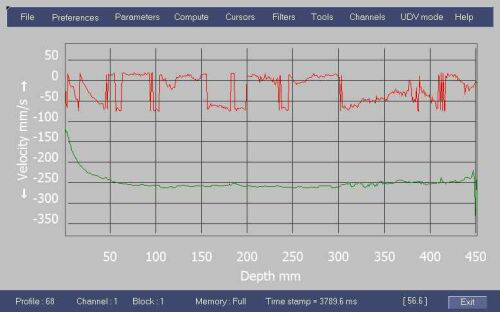The aliasing is inherent to the fact that the ultrasonic Doppler velocimetry uses a pulsed emission.
This implies that the maximum measurable Doppler frequency is the half of the pulsed repetition
frequency (Nyquist limit). Nevertheless, UDOP offers two ways to overcome that limitation.
An often used method is based on the assumption that the velocity can't change more than a definite
amount between two adjacent gates. This method implies that:
- the measured velocity profile contains always at least one correct velocity value (not aliased) at a known depth.
- the noise level must be much below the velocity deviation used to correct the profile.
The basic idea of this method is to take into account the phase difference resulting from a change in the PRF between two successive emissions.
The figure below shows an example how the new developed method corrects, here up to 3 times, the aliasing contained in the aliased red curve.


